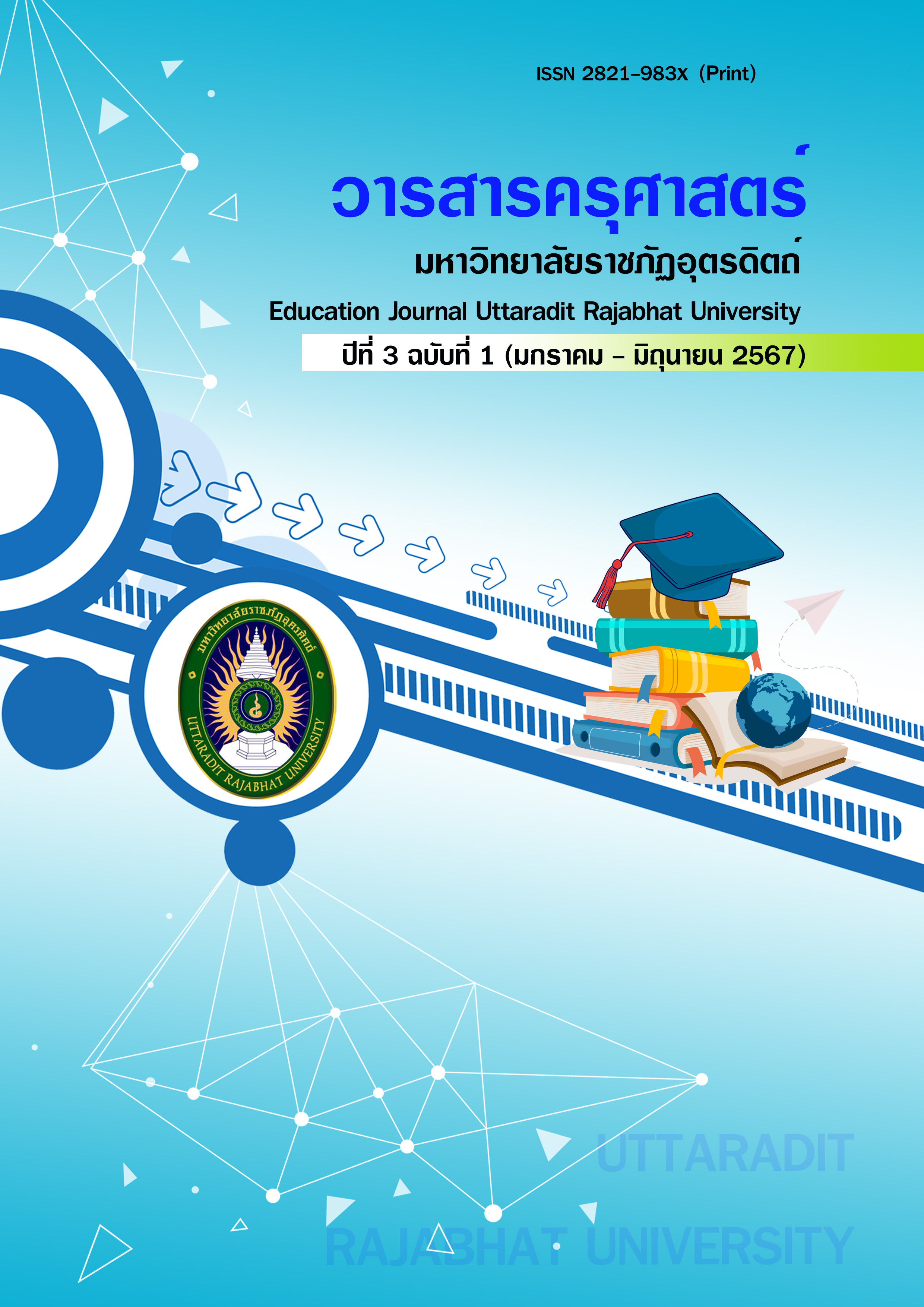Vonder Go The Development of Mathayom 2 Students’learning Outcomes through 5Es Learning Management and Vonder Go Game
Main Article Content
Abstract
This research aimed to design and implement 5Es learning activities with Vonder Go game on the topic of Human Reproductive System to develop academic achievement of Mathayom 2 students and to study the level of students’ satisfaction with the learning management. The purposively selected sample group was Mathayom 2 students of Ban Pong Sanuk School, Pua District, Nan Province in the first semester of the academic year 2023, totaling 24 students. The research instruments were 5Es learning lesson plans with Vonder Go game on the topic of Human reproductive system, pre-test and post-test, and student satisfaction questionnaire. The results of the study found that students had an average posttest score of 12.91 ± 6.41, which was significantly higher than the pre-test score of 9.92 ± 7.61 at the 0.05 level. Students were also most satisfied with the learning activities, with an average score of 5.00 ± 0.00. From the results of the study, this could be noted that the academic achievement of Mathayom 2students is able to be enhanced through 5Es learning activities with Vonder Go game.
Keywords: academic achievement; Human Reproductive System; 5Es learning activities; Vonder Go game
Article Details

This work is licensed under a Creative Commons Attribution-NonCommercial-NoDerivatives 4.0 International License.
Faculty of Education Journal Uttaradit Rajabhat University It is a medium for disseminating research results. Academic work Any opinions expressed in the article are solely the personal opinions of the author. Faculty of Education Uttaradit Rajabhat University and the editorial team does not necessarily have opinions that are consistent with those expressed in the article in any way. and is not considered the responsibility of the Faculty of Education Uttaradit Rajabhat University and editorial team
References
กระทรวงศึกษาธิการ. (2551). หลักสูตรแกนกลางการศึกษาขั้นพื้นฐาน พุทธศักราช 2551. กรุงเทพฯ: ชุมนุมสหกรณ์เกษตรแห่งประเทศไทย.
ชญานิษ นกแกšว. (2566). “วอนเดอร์” เอดเทคสตาร์อัพสร้างเกมมิฟเคชั่น สร้างการเรียนรู้ให้สนุก. (กรุงเทพ ธุรกิจ).
นงพะงา สุวพิศ. (2561). ผลการจัดการเรียนรู้แบบวัธจักรการเรียนรู้ 5 ขั้น โดยใช้เกมประกอบเรื่อง สมบัติสารที่มีต่อผลสัมฤทธิ์ทางการเรียนและทักษะกระบวนการทางวิทยาศาสตร์ของนักเรียน ชั้นประถมศึกษาปีที่ 3 โรงเรียนขยายโอกาสขนาดกลาง อำเภอเมือง จังหวัดชุมพร. (ออนไลน์),1-14.
ณัฐกฤตา บุญเมืองธนาภา, พาทีเกศ ธนากร, และ กรัณย์ พลวิวรรธมงคล. (2564). การเปรียบเทียบผลสัมฤทธิ์ทางการเรียน ทักษะการคิดตามแนวสะเต็มศึกษา ความคงทนในการเรียนรู้ โดยใช้ชุดกิจกรรมการเรียนรู้ตามแนวสะเต็มศึกษาร่วมกับการจัดการเรียนรู้เทคนิคเกมการศึกษาและการจัดการเรียนรู้ แบบสืบเสาะหาความรู้ สำหรับนักเรียนชั้นมัธยมศึกษาปีที่ 1. วารสารนวัตกรรมการศึกษาและการ วิจัย, 7(3), 731-746.
ณฐาพัชร์ วรพงศ์พัชร์, ธนา โยธาชัย, ชุติมา พรราย, และ สุธิดา ไชยชนะ. (2567). การพัฒนานวัตกรรมการเรียนรู้รายวิชาวิทยาศาสตร์และเทคโนโลยีโดยการจัดการเรียนรู้แบบวัฏจักรการสืบเสาะหาความรู้ (5E) ร่วมกับการใช้เกม โรงเรียนวัดทุ่งเหียง จังหวัดชลบุรี. วารสารบัณฑิตศึกษาชัยภูมิปริทรรศน์, 2(1), 34-47.
บุญชม ศรีสะอาด. (2560). การวิจัยเบื้องต้น. พิมพ์ครั้งที่ 10. กรุงเทพฯ: สุวีริยาสาส์น.
ศิราพร สันหลี. (2564). ผลของการจัดการเรียนรู้สืบเสาะแบบ 5E ร่วมกับเกม เพื่อพัฒนาทักษะ กระบวนการทางวิทยาศาสตร์ขั้นสูง เรื่อง งานและพลังงาน ของนักเรียนชั้นมัธยมศึกษาปีที่ 2. (ออนไลน์), 1-140.
ทัศมา ดือราแม,นาเดีย บาเกาะ,มูรมีนะห์ ยูโซ๊ะ,โนรอาตีกะห์ สามารอเม๊าะ,นูรีซัน ยะโก๊ะ,ฟารูดี ดือเล๊าะ. (2564). การพัฒนาผลสัมฤทธิ์ทางการเรียนของนักเรียนระดับชั้นมัธยมศึกษาปีที่ 3 ผ่านการจัดกิจกรรมการเรียนรู้โดยใช้เกมวันเดอร์ โก (Vonder do) รายวิชาเทคโนโลยีการออกแบบและเทคโนโลยีเรื่องเทคโนโลยีแก้ปัญหาโรงเรียนเดชะปัตตนะยานุกูล จังหวัดปัตตานี. (ออนไลน์), 1-75.
สาธิยา ภูนาพลอย, ศิริลักษณ์ พึ่งรอด, และ นราศักดิ์ ภูนาพลอย. (2566). ระบบจัดการเรียนรู้แบบ Active Learning สำหรับการศึกษาในศตวรรษที่ 21. วารสารนวัตกรรมการเรียนรู้และการศึกษาทั่วไป, 1(2), 61-72.
อมรา อัคเส. (2563). การพัฒนาแนวทางการสื่อสาร เรื่อง เพศของหญิงตั้งครรภ์วัยรุ่นกับครอบครัว. วารสารสุขภาพและสิ่งแวดล้อมศึกษา, 5(3), 148-160.


